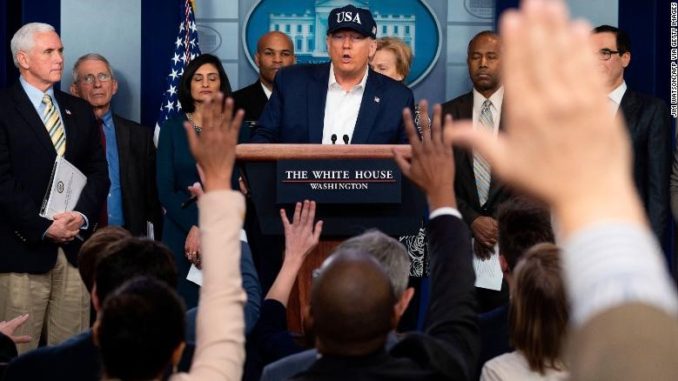
by: Cheryl Hancock-Watts
There are so many stories in the media, about President Trump not acting quick enough to shut the U.S. borders, yet he was criticized when he shut them down! As the information from the World Health Organization (WHO) and the Centers for Disease Control (CDC) concerning the Corona Virus Disease 2019 (CoVid-19) came to Trump, they reassured him all through January and much of February that, “The risk to Americans remains low.” Yet others, such as Rep. Liz Cheney of Wyoming and Senator Tom Cotton from Arkansas were blowing the whistle loud, asking Trump to close the borders. So, on January 17th, travel restrictions began, and on January 31 Trump issued a ban on travel between the U.S. and China.
Also, on January 31st, the WHO said that travel restrictions can cause more harm than good by hindering info-sharing & medical supply chains. It warned that closing borders could accelerate the spread of CoVid-19 if travelers enter countries unofficially. China criticized the travel restrictions, accusing the U.S. of ignoring official advice. China said, “The WHO recommended against travel restrictions, but the US ignored them, this is not a gesture of goodwill.”
Times of Israel Feb 2, 2020 – The United States and Australia are leading a growing list of countries, including Israel, that are putting temporary but sweeping travel restrictions on Chinese nationals or those who have traveled to China within the last 2 weeks.
Following is the edited version of an article by Cleta Mitchell, The Federalist, 3/31/20
The Coronavirus Chronology
Although the first case of the coronavirus was reported in Wuhan, China in early December 2019, the Chinese authorities continued through Jan. 2020 to downplay the potential for the disease to spread. The WHO reinforced China’s falsehoods, saying on Jan. 14 that “Investigations conducted by the Chinese authorities have found no clear evidence of human-to-human transmission of the coronavirus identified in Wuhan, China.” This was 5-6 weeks after the opposite was already confirmed to be the case in Wuhan.
Jan. 17, the CDC and the Department of Homeland Security announced that American citizens returning from travel-restricted countries were being rerouted to specific airports, where they would be screened and isolated. CDC on that day also stated that, “The risk from CoVid-19 to the Americans is currently deemed to be low.”
Jan. 21: First case of CoVid-19 in the U.S. was reported, the man traveled from Wuhan, China.
Jan. 24: The CDC confirmed the 2nd U.S. case of CoVid-19, adding “The immediate risk to America remains low.”
Jan. 28: The World Health Organization (WHO) praised China for its “speed and openness” with the virus.
Jan. 28: Trump expanded U.S. airport screenings and mandatory quarantines for travelers showing symptoms.
Jan. 30: The WHO declared a global health emergency of International concern.
Jan. 31: President Trump declared coronavirus a U.S. public health emergency and issued the ban on travel between the U.S. and China. On that same day, the Senate voted on the production of additional documents in the impeachment trial of President Trump. Trump was fighting two battles at the same time.
Feb.18: The CDC reaffirmed that the “risk to Americans from coronavirus is low.”
Feb. 26: The Trump Administration raised travel warnings to their highest level for Japan and South Korea. On that day the first case of suspected local transmission in the U.S. was announced by the CDC.
Feb 26: Trump named Vice President Pence to lead the Coronavirus Task Force.
March 12: Trump imposed travel restrictions on Europe and elsewhere.
March 13: President Trump declared a national emergency.
The single most important step taken by Trump was his closing of U.S. travel with China early on.
It is impossible to overestimate the number of American lives saved by that momentous decision.
Thank you, President Trump for acting for the American people against all opposition!
